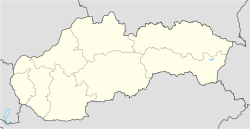Gelnica
Gelnica
German: Göllnitz | |
|---|---|
Town | |
 Main square of Gelnica | |
 Coat of arms | |
 Gelnica Location of Gelnica in Slovakia | |
| Coordinates: 48°50′53″N 20°56′14″E / 48.84806°N 20.93722°ECoordinates: 48°50′53″N 20°56′14″E / 48.84806°N 20.93722°E | |
| Country | Slovakia |
| Region | Košice |
| District | Gelnica |
| First mentioned | 1246 |
| Government | |
| • Mayor | Dušan Tomaško |
| Area | |
| • Total | 57.652 km2 (22.260 sq mi) |
| Elevation | 372 m (1,220 ft) |
| Population (2018-12-31[1]) | |
| • Total | 6,076 |
| • Density | 110/km2 (270/sq mi) |
| Time zone | CET (UTC+1) |
| • Summer (DST) | CEST (UTC+2) |
| Postal code | 056 01 |
| Area code(s) | +421-53 |
| Car plate | GL |
| Website | www.gelnica.sk |
Gelnica (Hungarian: Gölnicbánya, German: Göllnitz) is a town in the Košice Region of Eastern Slovakia. It has a population of 6,076.
Names[]
The name comes from the name of the river derived from Slavic word hnilý (rotten). The initial g in the German form Göllnitz indicates that the name was adopted by Germans before the spirantisation of Slavic g to h in Slovak (around the 12th century). The current Slovak name Gelnica comes from this secondary German form. The Hungarian Gölnicbánya (bánya – mine) refers to the town's mining activity.
Geography[]
It is located in the northern part of the Slovak Ore Mountains, in the Hnilec river valley, which flows a few kilometres downstream into Hornád. The town lies at the both banks of Hnilec, has an altitude of 375 metres (1,230 feet), and is located around 38 kilometres (24 miles) from Košice.
History[]
Carpathian Germans chiefly from Bavaria began to settle the formerly Slavic settlement during the 13th century. By 1264 it was an established mining town and became a royal mining town of the Kingdom of Hungary by 1276, from where the first mentioned is recorded (as "Gelnic"). For many years Gelnica was a chief mining town in Szepes County of the Kingdom of Hungary. Silver, copper, but also gold, quicksilver, lead and iron ore were mined in the mines. Between 1465–1520, Gelnica lost most of its privileges. The town's population in the second half of the 16th century is estimated at 1000 people, whereby the ratio of Germans and Slovaks, who were the main ethnic groups, is estimated to have been 3:1.[2] In 1910, the town's population of 3833 inhabitants consisted of 2095 Germans, 1098 Slovaks and 606 Hungarians.[3] The German population was expelled in 1945.
Sights[]
The town includes the ruins of a medieval castle, destroyed by a fire in 1685. Other attractions include a Gothic church and Renaissance town hall, both remodelled along Baroque lines, and a mining museum.
Demographics[]
According to the 2001 census, the town had 6,404 inhabitants. 95.92% of inhabitants were Slovaks, 1.55% Roma, 0.84% Germans and 1.02% Czechs.[4] The religious makeup was 72.00% Roman Catholics, 15.88% people with no religious affiliation, and 4.03% Lutherans and 3.28 Greek Catholics.[4]
Twin towns — sister cities[]
Gelnica is twinned with:[5]
See also[]
References[]
- ^ "Population and migration". Statistical Office of the Slovak Republic. Retrieved 2019-04-16.
- ^ Martin Štefánik – Ján Lukačka et al. 2010, Lexikón stredovekých miest na Slovensku, Historický ústav SAV, Bratislava, 2010, p. 156, ISBN 978-80-89396-11-5. http://forumhistoriae.sk/-/lexikon-stredovekych-miest-na-slovensku Archived 2017-03-26 at the Wayback Machine
- ^ "1910 Census of the Kingdom of Hungary". 1910.
- ^ Jump up to: a b "Municipal Statistics". Statistical Office of the Slovak republic. Archived from the original on May 13, 2007. Retrieved 2008-01-09.
- ^ "Partnerské mestá". gelnica.sk (in Slovak). Gelnica. Retrieved 2019-09-09.
External links[]
- Town website (in Slovak)
- Surnames of living people in Gelnica
- Cities and towns in Slovakia
- Spiš
- Geography of Košice Region
- Košice Region geography stubs
